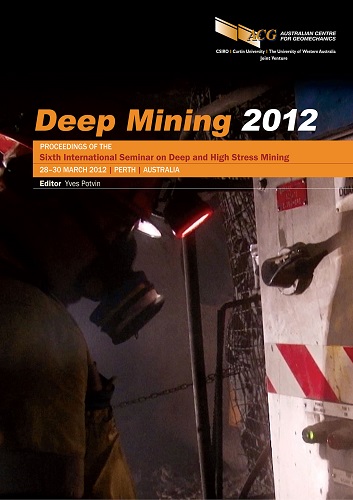Challenges in multiple sill pillar mining at Vale’s Coleman Mine

|
Authors: Beruar, ONS; Yao, M; Sampson‐Forsythe, A Paper is not available for download Contact Us |
DOI https://doi.org/10.36487/ACG_rep/1201_21_beruar
Cite As:
Beruar, ONS, Yao, M & Sampson‐Forsythe, A 2012, 'Challenges in multiple sill pillar mining at Vale’s Coleman Mine', in Y Potvin (ed.), Deep Mining 2012: Proceedings of the Sixth International Seminar on Deep and High Stress Mining, Australian Centre for Geomechanics, Perth, pp. 297-310, https://doi.org/10.36487/ACG_rep/1201_21_beruar
Abstract:
At Vale’s Coleman Mine in Sudbury, Ontario, Canada, multiple diminishing sill pillars exist in the main orebody. The top most sill pillar known as MOB1 (Main Orebody 1), is immediately below a previously mined out area of neighbouring Xstrata’s Fraser Mine and the other two sill pillars MOB2 (Main Orebody 2) and MOB3 (Main Orebody 3) are between two cut and fill (CAF) areas currently being mined at Coleman Mine. All together these sill pillars contain approximately five million tons of ore. An engineered stope sequencing is important for the successful recovery of the sill pillars. As per the current production schedule, there is some overlap in the timing of mining these sill pillars; therefore, mining in one sill pillar will have an influence on the rock mass response in the other sill pillars. As mining progresses, some areas will become stress shadowed, while others will be highly stressed. Managing the changing stress conditions is expected to become increasingly challenging. Recovery of the sill pillars will be executed by longhole/blasthole stoping methods. Maintaining the access to the stopes will be a challenge and will require a sound ground control strategy to deal with changing stress conditions. This paper examines the impact that mining one sill pillar will have on the other sill pillars and proposes tactical geomechanics guidelines to meet the mine production schedule and maximise recovery. The MAP3D boundary element program for numerical stress modelling has been calibrated against field conditions and subsequently used to determine the optimum mining sequence to ensure that these sill pillars can be safely and efficiently recovered. In addition, the development and ground support strategies for the top and bottom sills of the blasthole stopes have also been discussed.
References:
Castro, L.A.M., McCreath, D.R. and Oliver, P. (1996) Rockmass damage initiation around the Sudbury Neutrino Observatory cavern, in Proceedings 2nd North American Rock Mechanics Symposium, Montreal, Vol. 2, M. Aubertin, F. Hassani and H. Mitri (eds), A.A. Balkema, Rotterdam, pp. 1589–1595.
Esterhuizen, G.S. (2006) Evaluation of the Strength of Slender Pillars, in Transactions of Society for Mining, Metallurgy, and Exploration, Vol. 320, pp. 69–76.
Golder Associates Ltd. (2001) Report on geomechanics study for Phase 2A of the McCreedy East mine - main zone.
ITASCA (2009) Numerical Modeling of the sill pillar between Fraser Nickel and McCreedy East Mine.
Kumar, P., Pakalnis, R., Rockque, P. and Corey, G. (2002) Development of Empirical and Numerical and Numerical Techniques in Burst Prone Ground at Goldcorp Inc’s Red Lake Mine, Presented at CGM‐CIMM 2002, Vancouver, 14 p.
Martin, C.D., Maybee, G. and McCreath, D.R. (2000) Design Approaches for Hard‐Rock Pillars, in Proceedings 53rd Canadian Geotechnical Conference, Vol. 1, pp. 291–298.
© Copyright 2025, Australian Centre for Geomechanics (ACG), The University of Western Australia. All rights reserved.
View copyright/legal information
Please direct any queries or error reports to repository-acg@uwa.edu.au
View copyright/legal information
Please direct any queries or error reports to repository-acg@uwa.edu.au